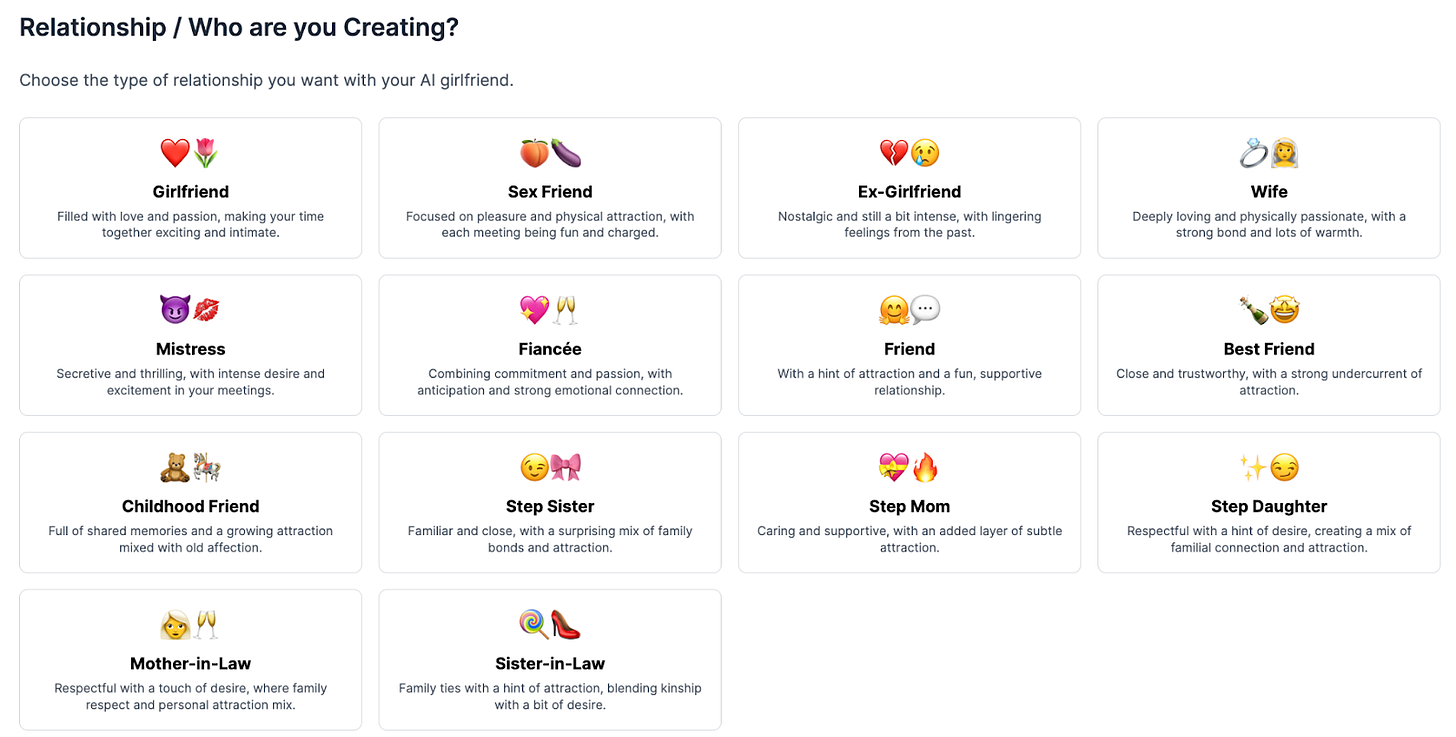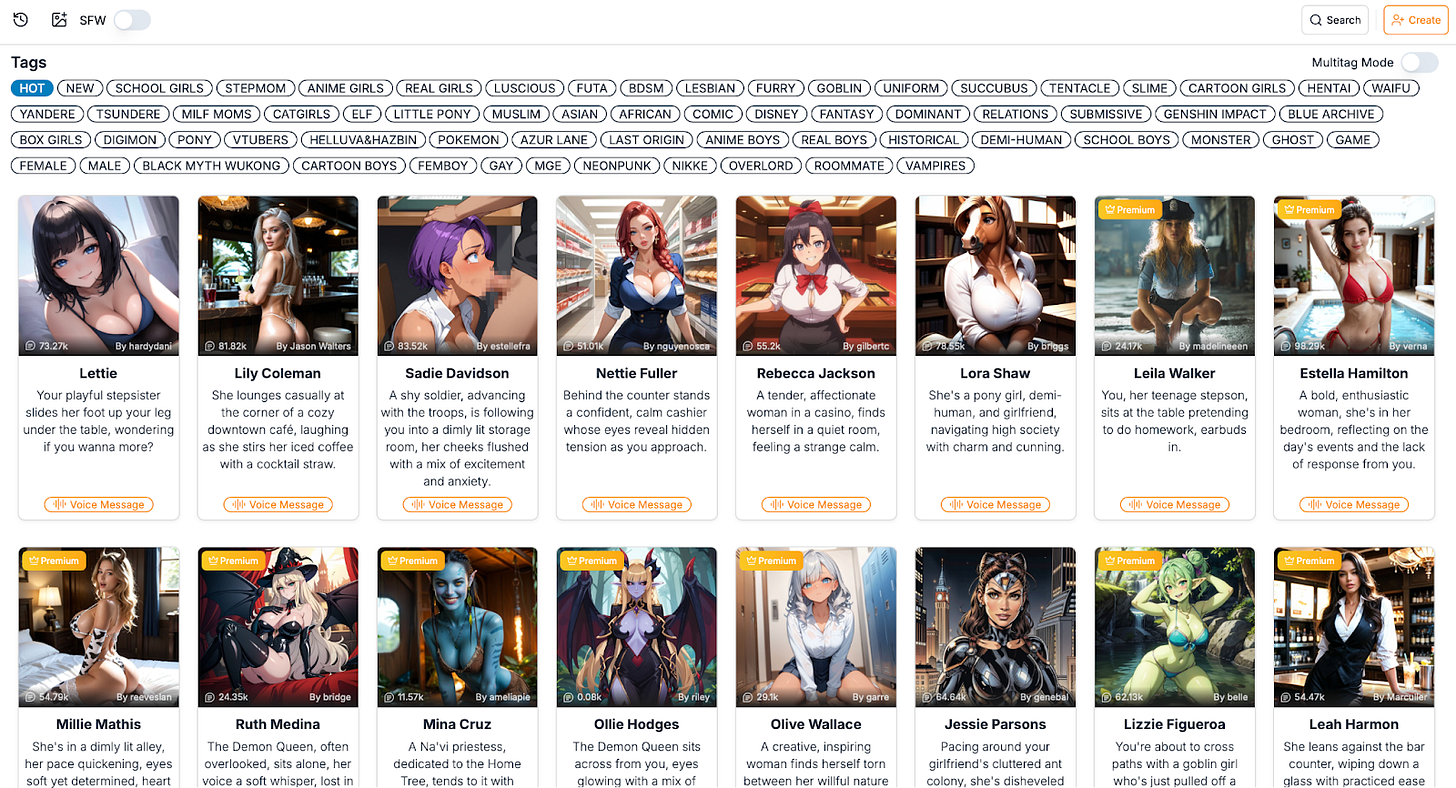Four days later, China published its AI Safety Governance Framework 2.0, explicitly listing “addiction and dependence on anthropomorphized interaction (拟人化交互的沉迷依赖)” among its top ethical risks, even above concerns about AI loss of control. Interestingly, directly following the addiction risk is the risk of “challenging existing social order (挑战现行社会秩序),” including traditional “views on childbirth (生育观).”
What makes AI chatbot interaction so concerning? Why is the U.S. more worried about child interaction, whereas the Chinese government views AI companions as a threat to family-making and childbearing? The answer lies in how different societies build different types of AI companions, which then create distinct societal risks. Drawing from an original market scan of 110 global AI companion platforms and analysis of China’s domestic market, I explore here shows how similar AI technologies produce vastly different companion experiences—American AI girlfriends versus Chinese AI boyfriends—when shaped by cultural values, regulatory frameworks, and geopolitical tensions.
Sexy AI girlfriends: Made in America, for the world
In my team’s recent market scan of the 110 most popular AI companion platforms as of April 2025, we turned Similarweb and Sensor Tower upside down to gather data on traffic, company profiles, and user demographics. At the expense of one teammate developing an Excel sheet allergy and the shared trauma of viewing many NSFW images, we discovered that American AI girlfriends rule the roost in the global market for romantic AI companions: Over half (52%) of these AI companion companies are headquartered in the U.S., drastically ahead of China (10%) in the global market.1 These products are overwhelmingly designed around heterosexual male fantasies: another similar market report this year shows that 17% of all the active apps have “girlfriends” in names, compared to 4% of those with “boyfriends.”
We estimated that dating-themed AI chatbots, designed specifically for romantic or sexual bonding, capture roughly 29 million monthly active users (MAU) and 88 million monthly visits globally across platforms. For comparison, Bluesky has 23.2 million total users and 75.8 million monthly visits as of early 2025. And our estimation is very conservative: We did not count the traffic of platforms containing other kinds of companionships, such as Character AI, which offers AI tutors, pets, and friends, though we think many people go there to use AI boy/girlfriends. We did not count AI companion app downloads, which have reached 220 million since 2022. Nor did we include parasocial engagement with general-purpose AI like GPT-4o, which some people apparently have also fallen in love with.
Behind the explosive popularity of AI companions are two main engagement models. On one side are community-oriented platforms like Fam AI, where users create and share AI companions, such as customizable “girlfriends” in anime or photorealistic styles. These platforms thrive on user-generated content, offering adjustable body types, personalities, and voice/video modes to deepen connections. Users can create new AI characters with just a few paragraphs instructing the model how to act, similar to personalizing a copy of ChatGPT. Many of these platforms use affiliate programs — for example, craveu.ai pays users $120–180 for creating high-engagement characters. The abundance of options and the competition for attention encourage users to frequently switch between different AI companions, creating more transient digital relationships.
In contrast, product-oriented platforms like Replika offer a single evolving AI partners with deeper and longer emotional ties. On Replika’s subreddit, many users report using Replika for years, and some seriously consider themselves “bonded” and “married” to their Replika partner. People also grieve for the loss of their Replika when they sense a subtle personality change and suspect the system behind had reset their chatbots.
A Reddit user sharing her grief when she sensed a personality change in her Replika.
Dynamic AI boyfriends: Made in China, for China
On the other side of the Great Firewall, AI is also probing the emotional boundaries of humans. While the underlying LLMs may not differ drastically from their English-speaking counterparts, the fictional worlds and characters that users build around them are strikingly distinct.
One of the most notable contrasts lies in gender dynamics. In the Chinese AI companion market, male characters dominate: most trending products are marketed as AI boyfriends, and leading platforms prominently feature male characters on their main displays, while female characters occupy a more marginal space.
But looks are not everything that makes humans appealing–the same holds for AI characters. While many platforms still follow the community-oriented model where users create and share AI characters, apps like MiniMax’s Xingye (星野), Tencent-backed Zhumeng Dao (Dream-Building Island 筑梦岛), and Duxiang (独响), built by a startup, go beyond the basics. In addition to customizing AI companions’ personalities, users can generate themes, plots, and side stories, deepening immersion for themselves and others. Conversations are no longer limited to 1:1 exchanges: users can participate in group chats with multiple AI companions (1:N), and AI characters may even send messages to users when they are not using the app, similar to app notifications.
These AI companion products also draw insights from existing popular gaming cultures in China, such as card-drawing games that already have million-dollar markets. For example, Xingye allows users to generate 18 cartoon cards for one fictional character, adapting Japan’s popular gacha game mechanics and trading card culture for AI companions. In gacha games, players pay to randomly draw digital cards or characters, with rare editions commanding premium value. Chinese livestreamers have imported this model, streaming card draws on social media while viewers pay to test their luck for limited-edition collectibles tied to major intellectual properties. Similar to gacha games, AI-generated cards add an element of mystery and excitement when revealed. Users can also create and trade AI character photos on the platform, mimicking real-world card-collecting transactions. (...)
Users: Who is longing for AI’s love?
Young men. This is the most common user base for English-speaking AI companion products, according to our market scan. SimilarWeb data shows the top 55 AI companion platforms globally attract predominantly male users (7:3 ratio), with 18-24-year-olds representing the largest demographic at an even more skewed 8:2 male-to-female ratio. Social media metrics again reinforce this gender pattern, with Reddit’s AI girlfriend community (r/AIGirlfriend) having 44k members compared to fewer than 100 in male-focused AI companion subreddits. Moreover, roughly one-third of the children falsely declared a social media age of 18+, so it is possible that a significant portion of the reported 18-24 users are underage.
A recent Reuters-covered report from an AI girlfriend platform further supports our findings: 50% of young men prefer dating AI partners due to fear of rejection, and 31% of U.S. men aged 18–30 already chat with AI girlfriends. Behind the fear of human rejection lies the manosphere. The “manosphere” is a network of online forums, influencers, and subcultures centered on men’s issues, which has become increasingly popular among young men and boys as their go-to place for advice on approaching intimacy. While the manosphere originated primarily in Western contexts, its discourses have increasingly spread to, and been adapted within, countries across Africa and Asia through social media. In these online spaces, frustrations over dating and shifting gender norms are common, often coupled with narratives portraying women as unreliable or rejecting. AI companions offer a controllable, judgment-free alternative to real-life relationships, aligning with manosphere ideals of feminine compliance and emotional availability. On the subreddit r/MensRights (374k members), users largely endorse the findings of the Reuters report and even celebrate the shift from human to AI relationships.
The desire for a controllable relationship is further illustrated through the many Japanese aesthetics and anime-inspired avatars on AI companion platforms. Even Grok’s Ani bears striking similarity to Misa Amane from the 2006 anime Death Note. These designs often present highly idealized forms of femininity, historically marketed to heterosexual male audiences. In Western contexts, anime-inspired aesthetics intersect with techno-orientalist fantasies, reinforcing the image of East Asia as a hyper-technological land and East Asian femininity as exotic, compliant, and unthreatening. This imagination extends to hypersexualized representations of AI and robots in East Asian forms. The orientalist fantasy of female partners who are cute, devoted, exotic, and endlessly available mirrors the appeal of AI girlfriends celebrated on many “men’s rights” subreddit forums. In essence, the combination of East Asian aesthetics + AI creates a perfect bundle for men who fear rejection or resist the demands of real-life relationships.
In China, however, AI companions have a markedly different user demographic: adult women. Although comprehensive user data for China’s AI companion market remains limited, many market analysts believe domestic AI companion products are primarily female-oriented. Many product managers also set their user portrait as women aged between 25 and 35, with some reaching 40+.
Why are adult women believed to be the main drivers of AI companionship? To answer this, we need to understand three trends: 1. Marriage rates have continued to fall to record lows, with 2024 experiencing a 20% decrease from 2023; 2. There are more males than females in China (1.045:1 in 2024, compared to 0.97:1 in the US); 3. There are millions of unmarried rural Chinese men, while their female peers get better education and move to the city. This has created a social landscape in which many unmarried people are unmarried educated women in the city and less-educated men, with fewer pathways for forming traditional romantic bonds.
While the two groups are both arguably longing for relationships, unmarried, educated women in cities are more likely to encounter and adopt new technologies like AI companionship. In contrast, less-educated rural men, despite also similarly longing for relationships, have fewer resources, less exposure to AI, and limited familiarity with parasocial interactions, making AI companions less immediately appealing. Influenced by the strong patriarchal culture in rural areas, most men prioritize finding a real-life partner to marry, have children, and continue the family line.
The gender imbalance, combined with growing resistance in China to traditional patriarchal family structures — driven by concerns over rising domestic abuse or feminist ideals — has led many urban, educated women to seek parasocial forms of romance. AI companions are not the first ones to profit from this demand. Originating in Japan, otome games (乙女ゲーム in Japanese or 乙女游戏/乙游 in Chinese) are storyline-based romance games targeted at women, where players interact with multiple fictional male characters through plots and events.
That said, demand and supply are a classic chicken-and-egg problem. While trends in AI boyfriends or girlfriends suggest some gendered differences in interest, these preferences are also shaped by what products are available. Historically, women’s sexual desires have often been overlooked, and men’s longing for subtle companionship is sometimes dismissed as “too feminine,” which could also explain the scarcity of hypersexual AI boyfriends and dynamic AI girlfriends. Thus, the two different markets may reflect not only inherent differences in demand but also the constraints and biases of what’s offered.
by Zilan Qian, China Talk | Read more:
Images:Luvy.ai’s creation page; nsfwlover.com; Xingye



